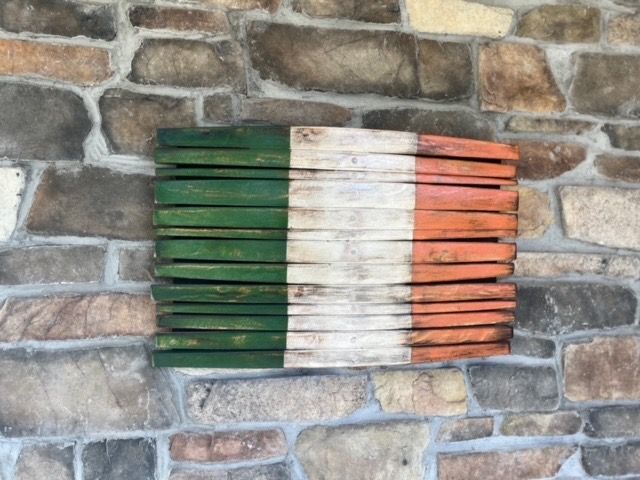Snap-Apple Night (1833) painted by Daniel Maclise. This Irish scene shows people playing divination games on October 31.
By Karen Frances McCarthy
It came as a surprise for the faithful in Ireland, and around the world, when one of the most authoritative spokesmen of the Roman Catholic Church, the Rev. Gino Concetti, announced in 1999 that not only is "communication … possible between those who live on this earth and those who live in a state of eternal repose," but "it may even be that God lets our loved ones send us messages to guide us at certain moments in our life."
This was no great surprise for the Celts who, on the festival of Samhain on October 31, celebrated the end of the harvest and the beginning of winter.
But with the fertile imagination of the Celt, that was only half of the story.
The transition between seasons opened a portal between worlds, which prompted them to light bonfires and don devilish garb to ward off nefarious phantoms.
It was in the eighth century that Pope Gregory III designated November 1 a time to honor all saints and martyrs (hallows), which just upped the ante on the mayhem perpetrated by ghostly skirmishing on Samhain, or Halloween as it became known, before the saints restored order the next day.
These days, Halloween is more of a children's holiday, but it still piques people's obsession with the macabre and fosters an excess of dark and mysterious pastimes, including rolling out the Ouija board, dressing up as witches, disemboweling pumpkins, watching horror films, and touring local cemeteries.
After all, who doesn't love a good midnight scare in a graveyard?
But these ghoulish midnight travels are vastly different from the graveyard festivities that happen in Central America, where Aztec and Catholic beliefs blend in a celebration of the Day of the Dead - the day the gates of heaven are thrown open and families are reunited for one day.
Sitting on graves, dressed and painted like they've been six-feet under for decades and welcoming spirits with open arms is a far cry from the fear of the supernatural at the heart of the Celtic-inspired Halloween world.
The horror story remains a Halloween staple.
Despite our squirming at the prospect of death, we are fascinated by its grotesquery.
Theories for this abound, from finding comfort in creating distance between us and violent acts we know aren't real, to purging negative emotions or relieving pent-up aggression, or indeed feeling vindicated that in Act III good triumphed and evil was vanquished.
Perhaps, it's a legacy of the Celtic desire to presume spirits evil, that the notion of spirits walking the earth is met with fear and superstition.
We tend to perceive the continued existence of the soul or consciousness as a perversion of the natural order.
Many who sense a presence are terrified that something from The Sixth Sense is lurking in the dark corners of the living room. Some burn sage in a blind panic, and others rush to a priest to escape the fate of Linda Blair in “The Exorcist.”
Perhaps it's due to warnings from the Church that raising the dead is an abomination and if something dead has arisen then something has gone scarily wrong. A notion not without iron considering resurrection is at the heart of the Christian faith.
One thing is certain, in modern society, particularly in America, we are increasingly discomforted by death. Historically, we were surrounded by high infant mortality, death in childbirth, plagues and influenza, which normalized death and made us aware of our own mortality from a very young age.
These days, we try to banish it from view. Increasingly, bodies are moved to funeral parlors, as we create a sophisticated funeral industry handle or wakes and bury our dead.
Given our discomfort with death, it is ironic that spiritualism emerged out of the New York Christian community in the mid-1800s, before the notion of communicating with the dead was considered the pathway to demonic possession or insane delusion.
Espousing the belief that death is not the end and that communication with the spirits of the deceased is possible, spiritualism swept through the Capitol and administrations from Lincoln to Coolidge.
It influenced men of letters and men of science, such as evolutionist Alfred Russell Wallace, Thomas Edison, and Carl Jung, before being destroyed in a maelstrom of opportunists, frauds, and parlor tricksters.
With it went all hope of mainstream acceptance of the survival of consciousness.
Discussion became derision, and open-minded scientific study became tantamount to career suicide. Nevertheless, scientists such as Dr. Raymond Moody (1975) and Dr. Eben Alexander (2012) have provided compelling evidence for survival of consciousness through near death experiences. Dr. Ian Stevenson (1980) produced persuasive case studies on reincarnation, and Bill and Judy Guggenheim (1997) compiled an extensive collection of accounts of people experiencing after death communication with loved ones.
Nevertheless, in our scientific reductionist culture, which, as the Dalai Lama said, perceives absence of evidence as evidence of absence, widespread acceptance of survival would need a miracle. But voices are increasingly making the case for consciousness not being an emergent property of the brain and thus not ceasing to exist when the brain dies.
Perhaps, someday, our consciousness will expand beyond what we think we know and we will realize that sensing the spirits of the dearly departed is a natural state of being, both here and in the hereafter. Perhaps, these visits will be widely accepted as comforting as we shift from the presumption that something is terribly wrong (either with the world or our sanity) to the acceptance that our loved ones are alive in spirit and are just here to say, "I'm here, and I love you."
Ultimately, the message of the Celts, of Catholicism, and increasingly of science is one of hope, the hope that we, like love, never die and that we continue to have a relationship with those who have passed from this world.
In this, we can transcend our smallness and see our connection to each other, to all things, and to something far greater than ourselves. In the meantime, let us welcome the living and the dead with open arms and open hearts, and let us celebrate, for at least one day, the triumph of life over death.
Karen Frances McCarthy is a published author, religion and spirituality writer, and former war correspondent based in New York and Dublin. She is currently writing her second book about science and religion in Ireland.










